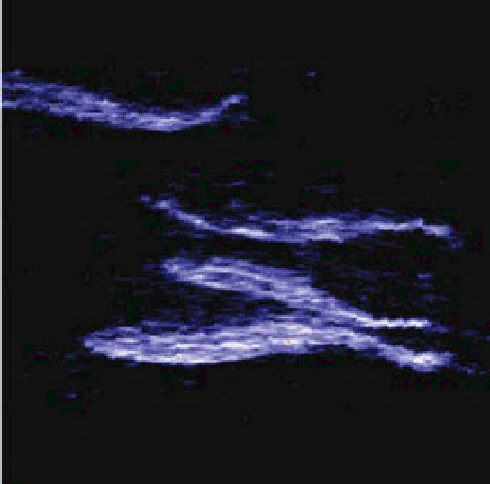Geography Reference
In-Depth Information
biovolume. This method allowed the determination of
biovolume-to-carbon and nitrogen conversion factors.
They also showed that the average volume of bacterial cells
was twice as high in polluted waters, while the bacterial
biomass was 35 times higher than in unpolluted water.
However, the combination of epifluorescent microscopy
and IA is still utilised for studying the functioning of food
webs and, subsequently, the recycling of nutrients (e.g.
Das et al., 2007).
At a larger scale, macrophyte biomass can be estimated
from reflectance measurements (see a review in Silva et al.
2008). Remote sensing has made it possible to assess the
biomass of a given species from the relationships between
reflectance values and ground estimations of the biomass
of submerged vegetation (Valta-Hulkkonen et al., 2004).
At a smaller scale, IA was shown to be a valuable tool
for accurate estimations of surface areas and volumes of
different plant parts (Gerber et al., 1994).
The estimation of invertebrate biomass (or secondary
production) often required detailed and time consum-
ing counting and measurement or organisms. IA can
perform such tasks at a reasonable speed and level accu-
racy. Alver et al. (2007) designed a particle counter for
making automatic measurements of rotifer densities. The
instrument automatically extracted samples from tanks,
and relied on a digital camera and image processing to
measure density. Due to its autonomous nature, this
apparatus could be used in monitoring and control pro-
cesses. Bernardini et al. (2000) developed a method to
quickly estimate individual biomass from video-recorded
images of macroinvertebrates. The corresponding soft-
ware automatically measured several body dimensions
(area, perimeter, minor and major axes) on each indi-
vidual and related these dimensions to dry weight using
linear regressions. In this study, body area was found
to be the best predictor of dry weight. In comparison,
Davis and Grayson (2007) showed that total body surface
area of newts (
N. viridescens viridescens
) provided a better
correlation with newt mass than did body length using
an automated IA; therefore total body surface area could
potentially serve as an alternative to estimate individual
mass or body condition.
Moreover, invertebrate biomass may be indirectly
assessed from vegetation characteristics. McAbendroth
et al. (2005) used fractal indices to describe the structural
complexity of mixed stands of aquatic macrophytes, and
these were employed to examine the effects of habitat
complexity on the composition of invertebrate assem-
blages. After IA, and especially the quantification of the
fractal dimension of both perimeter and area, fractal
Figure 17.11
Image of swimming salmons, captured with an
imaging SONAR. Imaged sourced from http://www
.soundmetrics.com/industries-served/aquatic-life/fish-surveys,
and reproduced courtesy of Sound Metrics Corporation.
indices were found to be significantly related to both
invertebrate biomass scaled by body size and overall
invertebrate biomass: more complex stands of macro-
phytes contained a greater number of small animals.
During automated species recognition in fishways spec-
imens are usually counted (see 17.2.1.1 above). The most
common automatic methods for fish enumeration involve
acoustic techniques (Figure 17.11), which can be as accu-
rate as visual counts (e.g. Holmes et al., 2006). If necessary,
acoustic techniques can be coupled with imagery tech-
niques (e.g. shape description of fish schools: Reid and
Simmonds, 1993).
Enumeration of large animals (manatees, riverine dol-
phins, otters, flamingos
...
) can also be carried out from
air structures (e.g. planes, helicopters or fixed-wing plat-
forms). Although these counts are commonly processed
by eye, some low-resolution images (and/or high den-
sity populations) may need automatic procedures, for
which classical image processing tools such as mathe-
matical morphology are unsatisfactory. In this context,
techniques combining geometric models and environ-
mental constraints (colors, spatial repartition
...
)were
developed (Descamps et al., 2008; Figure 17.12). These
techniques are less time consuming than classical ones,
such as expert counting on some predefined small areas,
and avoid the associated interpolation procedures.

Search WWH ::

Custom Search